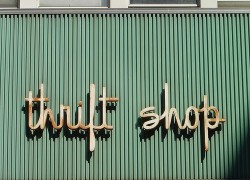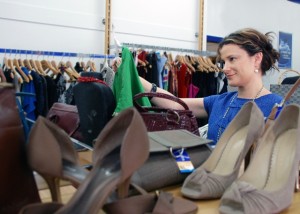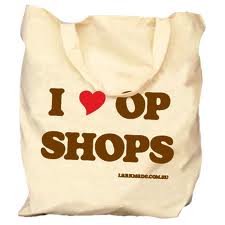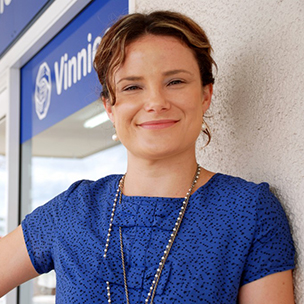The secret to op shopping
Posted on 18 March 2014.

I WHOLEHEARTEDLY blame my grandma for my love of op shops.
It all started before I went to school. As I was a very excitable (another term for talkative and a little bit of a handful) girl, my long-suffering parents would ship me off to my grandma’s for visits (aka time out for them).
In the beginning, my grandma would bribe me by saying we would visit op shops and if I was good (and didn’t wander off or mess up my dress which she had painstakingly made from fabrics she collected on said shopping trips) I was rewarded with a sweet treat. I’ve always been a sucker for cake.
At the start, and while biding my time before an attack on the cake stand, I used the time in shops to work out ways to remove the stupid girly ribbons from my unruly hair without my eagle-eyed grandma noticing, but then over time I began to explore the wonders of the charity shops we visited.
At first I would wander behind my stylish grandma and just touch all the beautiful fabric, but I soon began to pick up her tricks of the trade. Over time, her lessons on what fabrics to look for, how to look for good-quality labels and find quality clothes that with a little nip and a tuck there, would make a stunning and timeless piece began to connect.
And then it happened. One day we went to our favourite charity store – I still remember it as it was two streets away from a wonderful cake kitchen where the owner used to slip me ginger cookies with my milkshake – and lo and behold they had a sale. Fill a bag with anything from the store – for just $2.
Grandma handed me my own shopping bag and, in doing so, gave me the plastic reins to my lifelong passion for op shops. I never looked back, even when my friends at school teased me about my love of op shopping, while they all wore the SAME doc martins, surf shirts and denim skirts.
Even at university – a time when you are meant to be out there and forging ahead your own personality – I had some peers who would sit back with a look of disdain on their faces when I told them I got the vintage skirt and scarf from an op shop in the Annerley.
But, just like other female pioneers, I forged ahead. I even decided to launch my own education campaign by taking friends (and later discerning fashionista customers as I liked to call them) on op shop tours in my battered baby poo-coloured Toyota Corolla, which itself should have been in a vintage shop.
Over the years I have found some treasures, including a floor-length 1970s vintage Chanel dress, a stunning Spanish-influenced red velvet skirt, bohemian threads before they were bohemian, and endless classic books that are no longer in print.
I’ve found old suitcases (some even appeared in our wedding), stunning furniture pieces, gorgeous costume and estate jewellery, artwork, a funky jacket complete with someone’s concert ticket stub from seeing a band in St Kilda in the 80s.
I have also picked up day-to-day clothing, which has suited all of my many jobs (with a quarter of the price tag) from journalist to corporate businesswoman.
My favourite joke at barbecues is that through my op shops I’ve supported just about every charity there is and how can my husband question my shopping sprees when I say “but it supports charities”.
But I have noticed a trend in the past five years. No longer am I receiving odd looks when I say “oh this old thing? I picked this up at an op shop in West End.” Now people are saying “so can you give me some tips on how to get some similar bargains myself, I’m so tired of wearing all the same stuff as everyone else.”
Op shopping is no longer considered daggy. It’s considered normal for anyone – from any social status – to rifle through racks upon racks at charity shops for that special item, at a fraction of the price of new items or those seen at the growing number of vintage shops there seem to be.
On top of making use of the opportunity for budget-conscious shopping, people are opting for op shops in search of their own piece of individuality and for the joy of the search. They like going into a shop, rifling through racks of clothes and coming out with a handful of items (while not breaking the bank) which are unique and theirs. I dare anyone not to give themselves a mental high five when they stumble upon a designer item (with the tags still on) at a ridiculously low price.
For me, op shops provide you with individual pieces, with their own stories, while providing worthwhile charities funding for their great work. It’s philanthropy at play, and I get a nice jacket for my trouble.
It is truly the piece that just keeps on giving. And as for my grandma, if you see a red-haired woman in Indooroopilly, with cake crumbs on her stylish lapel, rifling through racks. Stay clear she’s a professional.
Happy op shopping!
Fifteen tips
- Always try on clothes before buying. Don’t think “ahh it’s cheap it won’t matter” as you’ll end up with a closet full of clothes you can’t wear.
- Never go expecting to find something. It’s not a retail store – it’s pot luck.
- Always go around stock-take sale time or at the end of seasons. Op shops will do clearouts.
- You will always find winter clothes at summer time and vice versa. We usually throw winter clothes out when we are sweltering and summer clothes out in winter when we can’t think about wearing that little amount of clothes.
- Always visit op shops around wealthier suburbs – they throw out the best stuff with store tags often still in place. They have the best finds and designer clothes. I always shop at op shops in select suburbs of Brisbane, North Sydney, inner-city Melbourne and around Noosa.
- Don’t think op shops are just for skinny minnies – most of us throw clothes out when we start to lose weight so often you will find brilliant clothes in all sizes (some often with the tags still on).
- Take the time to explore. Sometimes you can quickly run in and grab something in less than five minutes but often you need time to go through the racks.
- Op shops have cottoned on to the fact that people don’t think there are bargains so have often done the hard work for you – and have label racks now.
- The bigger chain of op shop are generally more expensive than the little charity shops.
- Join VIP lists – Endeavour has a great VIP program where it will often announce fashion parade and new-season events.
- Try to have cash on you. While most op shops now have EFPTOS facilities, it is easier for the charities if you have money.
- Make sure you donate back. Give your old clothes and items back to charity bins (don’t dump outside the bins as that is just rude!).
- The staff are volunteers – give them an extra smile. They are legends.
- All money goes to charity. If you can, round up your bill. If it comes to $11.50 give them $12. At the end of day, op shops are generally the main source of income for many charities.
- Op shops aren’t just for clothes. Some op shops (particularly the Lifeline at Virginia) have wonderful knick knacks and furniture.







